FRIDAY, OCTOBER 7
■ This evening, bright white Jupiter shines left of the bright white Moon.
Look much farther upper right of the Moon, by about four fists at arm's length, for Saturn. The Moon and Saturn form an isosceles triangle with Fomalhaut, which sparkles far below their midpoint.
■ Perseus is up in the northeast after dark now, including the eclipsing variable star Algol, Beta Persei. This evening Algol should be at its minimum brightness, magnitude 3.4 instead of its usual 2.3, for a couple hours centered on 11:12 p.m. EDT; 8:12 p.m. PDT. Algol takes several additional hours to fade and to rebrighten. Comparison-star chart.
■ Mercury is beginning its best week of 2022 as a dawn object. On Saturday morning look for it low due east about 60 to 40 minutes before your local sunrise, as shown below.
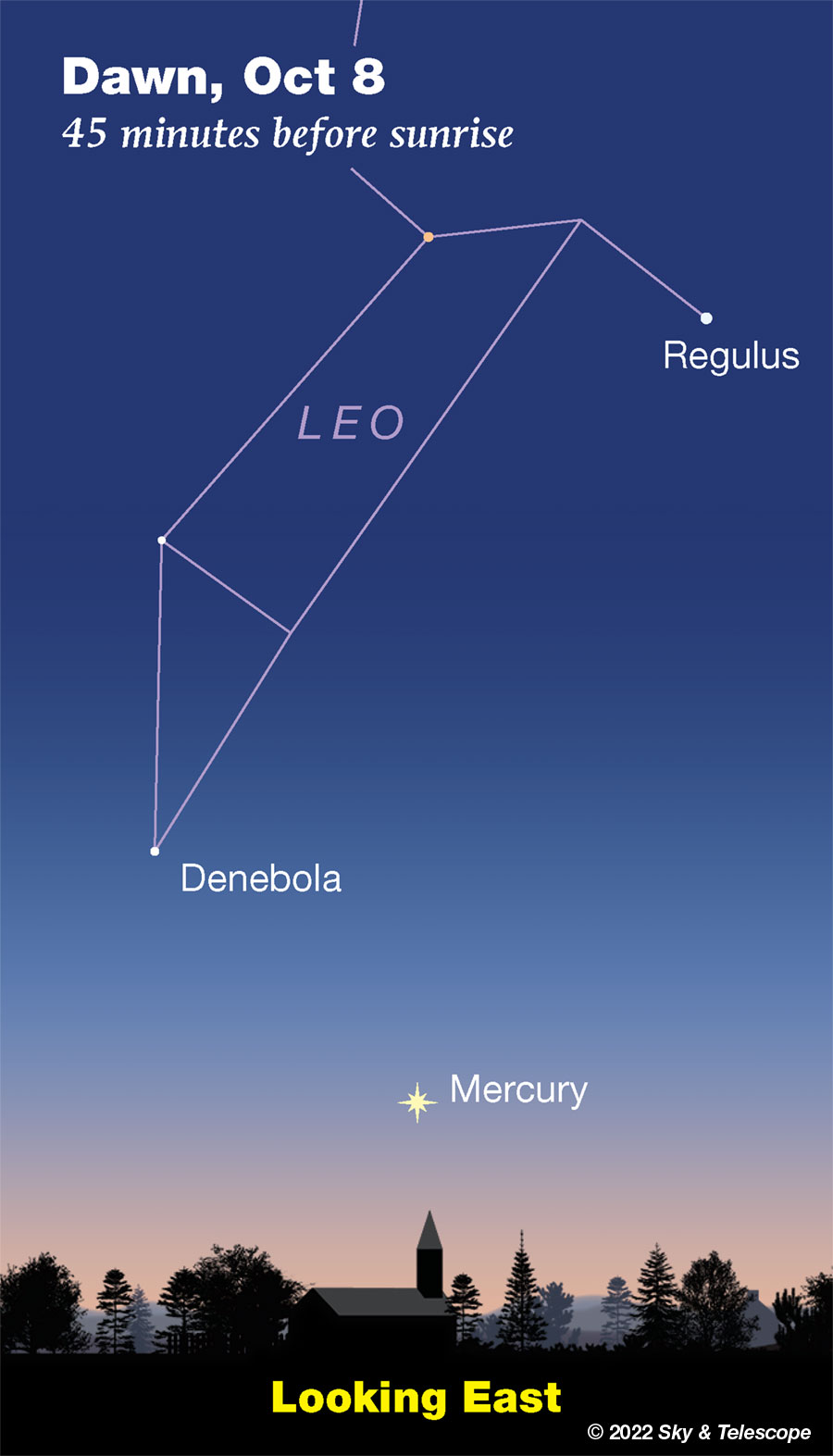
SATURDAY, OCTOBER 8
■ The Moon and Jupiter cross the sky together tonight. They start in the east-southeast, as shown below.
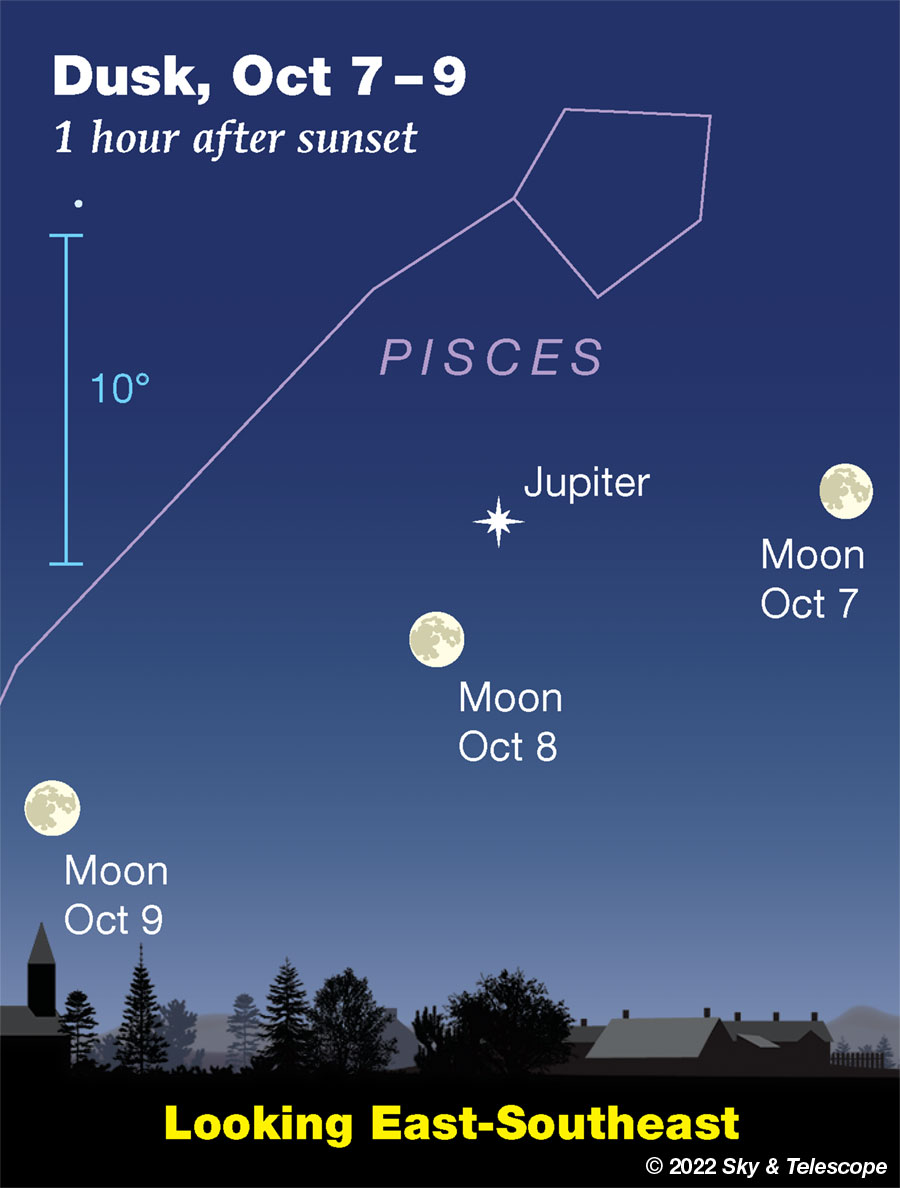
And why do the Moon and Jupiter shine together when they're on opposite sides of their respective oppositions: before it and after it?
That's because the Moon (rapidly orbiting Earth) always moves eastward with respect to the opposition point in Earth's sky, while outer planets always move westward with respect to the opposition point. Even when outer planets move eastward with respect to the stars, that motion is slower.
SUNDAY, OCTOBER 9
■ Full Moon (exact at 4:55 p.m. EDT). The Moon rises right around sunset. It hangs due east in late twilight. Look for Jupiter almost two fists to its upper right, as shown above. They move higher as evening proceeds.
Look high over the Moon for the Great Square of Pegasus through the moonlight. It's tilted up on one corner. The Moon itself is in eastern Pisces.
■ Think a full Moon means it's no time to observe the Moon? Use your imagination a bit, with the help of Bob King's Full Moon Fringe Benefits. For starters tonight: Have you ever seen Mare Orientale?
MONDAY, OCTOBER 10
■ Algol should be at minimum light around 8:00 p.m. EDT.
■ Jupiter's Great Red Spot should transit Jupiter's central meridian (the line down the middle of its disk from pole to pole) around 10:18 p.m. EDT. The Red Spot should be visible almost as easily for about an hour before and after in a good 4-inch telescope if the atmospheric seeing is sharp and steady. A light green or blue filter at the eyepiece helps a bit.
Jupiter rotates fast; the Red Spot transits about every 9 hours 56 minutes. But not quite like clockwork! It drifts east or west in Jupiter's atmosphere somewhat irregularly. A change often becomes detectable to visual transit timers over a span of some months. Our Red Spot transit-time predictions — see the Celestial Calendar section of Sky & Telescope — are based on fairly recent observations, but don't be surprised if the Spot has taken it into its head to move several minutes off schedule.
TUESDAY, OCTOBER 11
■ This is the time of year when, after nightfall, W-shaped Cassiopeia stands on end halfway up the northeastern sky — and when, off to its left in the north, the dim Little Dipper extends leftward from Polaris. The Little Dipper's two brightest stars (2nd magnitude) are Polaris, the end of its handle due north, and Kochab, the lip of its bowl about a fist and a half to the left.
WEDNESDAY, OCTOBER 12
■ Vega is the brightest star very high toward the west these evenings. Face west and look way up.
To Vega's right or lower right by 14° (nearly a fist and a half at arm's length), look for Eltanin, the nose of Draco the Dragon. The rest of Draco's fainter, lozenge-shaped head is a little farther behind. Binoculars will help through the moonlight; Draco's head is about the width of a typical binocular's field of view.
Draco always eyes Vega as they wheel around the sky.
The main stars of Vega's own constellation, Lyra — faint at 3rd and 4th magnitude — extend to Vega's left by half as far as the distance from Vega to Eltanin. Again, binoculars will help.
■ Jupiter's Great Red Spot should transit the planet's central meridian around 11:56 p.m. EDT; 8:56 p.m. PDT.
THURSDAY, OCTOBER 13
■ This evening, skywatchers at mid-northern latitudes finally have about 40 minutes of darkness between the end of twilight and moonrise. Use it to get a nicer look at the Great Square of Pegasus, balancing on its corner high in the east above Jupiter.
Away from the Great Square's left corner runs the main line of Andromeda, three 2nd-magnitude stars about as bright as those of the Square and spaced similarly far apart. (The three include the Square's corner.) This whole dipper-shaped pattern was named the Andromegasus Dipper by the late Sky & Telescope columnist George Lovi — to accompany the Big and Little Dippers, the Milk Dipper of Sagittarius (nowadays usually subsumed into the Teapot), and the tiny dipper pattern of the Pleiades.
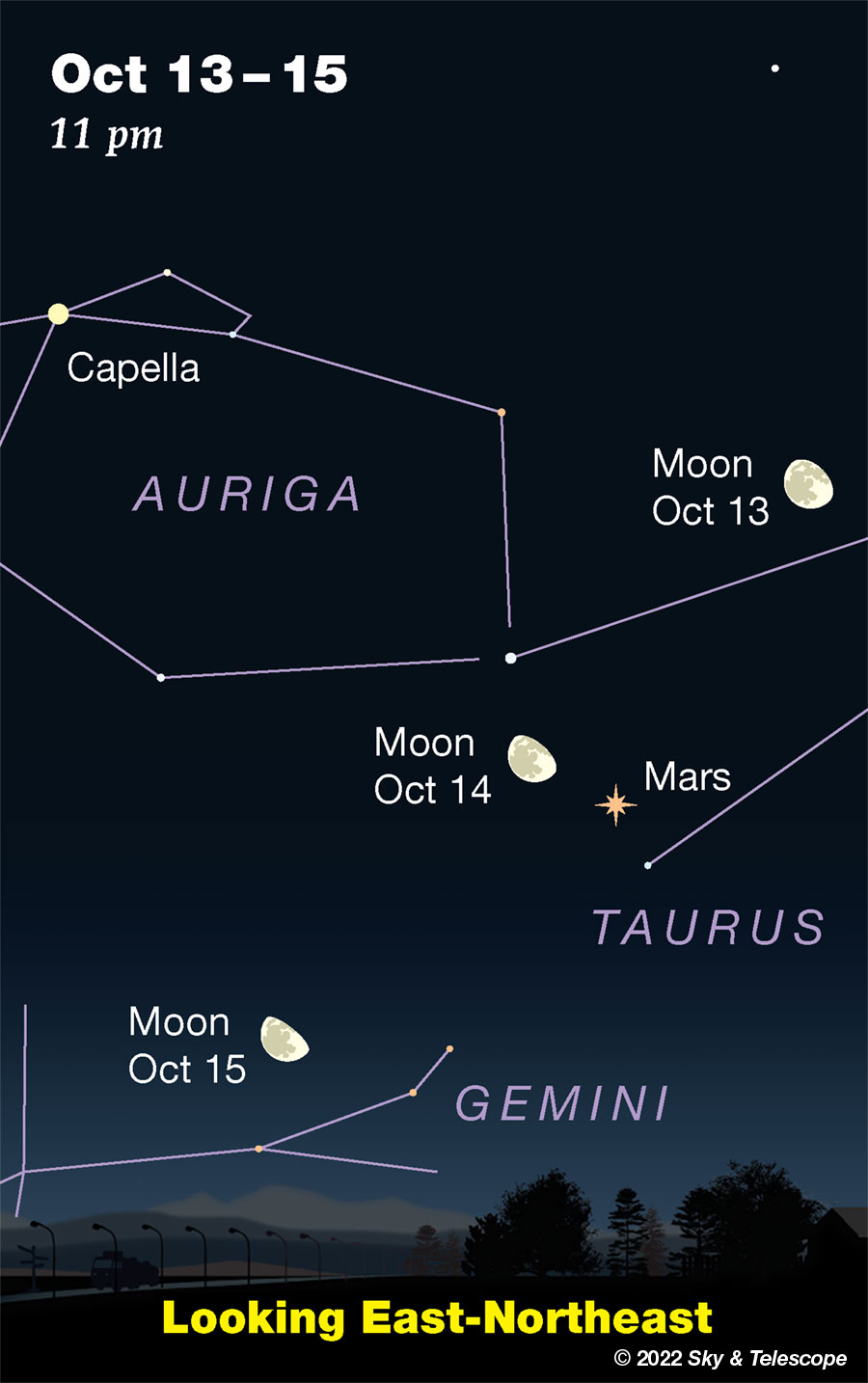
Once again, the Moon and an outer planet demonstrate that they shine together on opposite sides of their opposition dates. The Moon was full last Sunday, while Mars will reach opposition December 1st.
FRIDAY, OCTOBER 14
■ Once the waning gibbous Moon rises after about 9 p.m. tonight, look to its right or lower right for bright Mars. By 11 they're nice and high, as shown above. They're both between the horntip stars of Taurus (for evening in the Americas).
SATURDAY, OCTOBER 15
■ Now that it's mid-October, Deneb has replaced Vega as the zenith star after nightfall (for skywatchers at mid-northern latitudes). Accordingly, Capricornus has replaced Sagittarius as the zodiacal constellation low in the south.
Vega, meanwhile, is still that brightest star high in the west. Less high in the southwest look for Altair, not quite as bright.
Just upper right of Altair, by a finger-width at arm's length, is little orange Tarazed. Down from Tarazed runs the dimmer stick-figure backbone of the constellation Aquila, the Eagle.
This Week's Planet Roundup
Mercury is having its best morning apparition of 2022. Look for it in early dawn, due east. Mercury is bright; it swells from magnitude –0.5 on October 9th to –0.9 on the 16th.
Venus is lost in the glare of the Sun.
Mars, magnitude –0.8 in eastern Taurus, clears the east-northeast horizon around 9 or 10 p.m. and gains altitude for the rest of the night. Mars is passing between the horntip stars of Taurus, Beta and Zeta Tauri. It will be exactly between them on the night of October 17th.
Mars-colored Aldebaran, sparkling off to its upper right at magnitude +0.9, can hardly compete. Look above Aldebaran for the Pleiades.
Telescopically, Mars is 13 arcseconds in diameter and growing. The best time to examine it is when it's very high in the hours before dawn. Mars will reach 17.2 arcseconds diameter when closest to Earth in December.
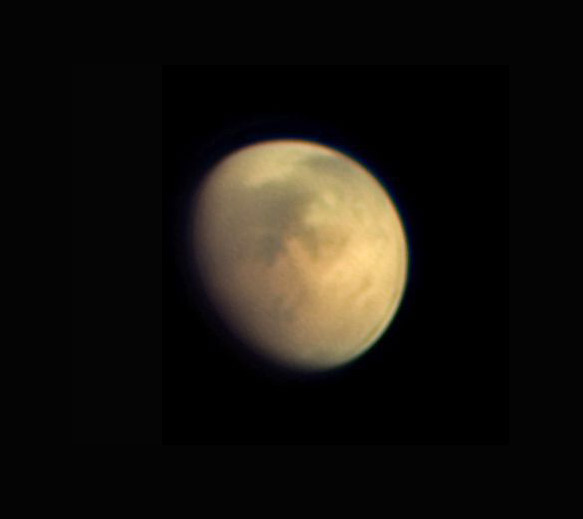
Jupiter is three weeks past opposition. As twilight fades, spot it glaring in the east-southeast. After dark Jupiter dominates its part of the sky, blazing at magnitude –2.9 in dim Pisces. It climbs higher across the southeast and stands highest in the south around midnight.
In a telescope Jupiter is still a remarkable 49 arcseconds wide across its equator, near its maximum possible; Jupiter this season is very close to the perihelion of its 12-year orbit around the Sun. See Jupiter's Exceptionally Close Opposition by Bob King.
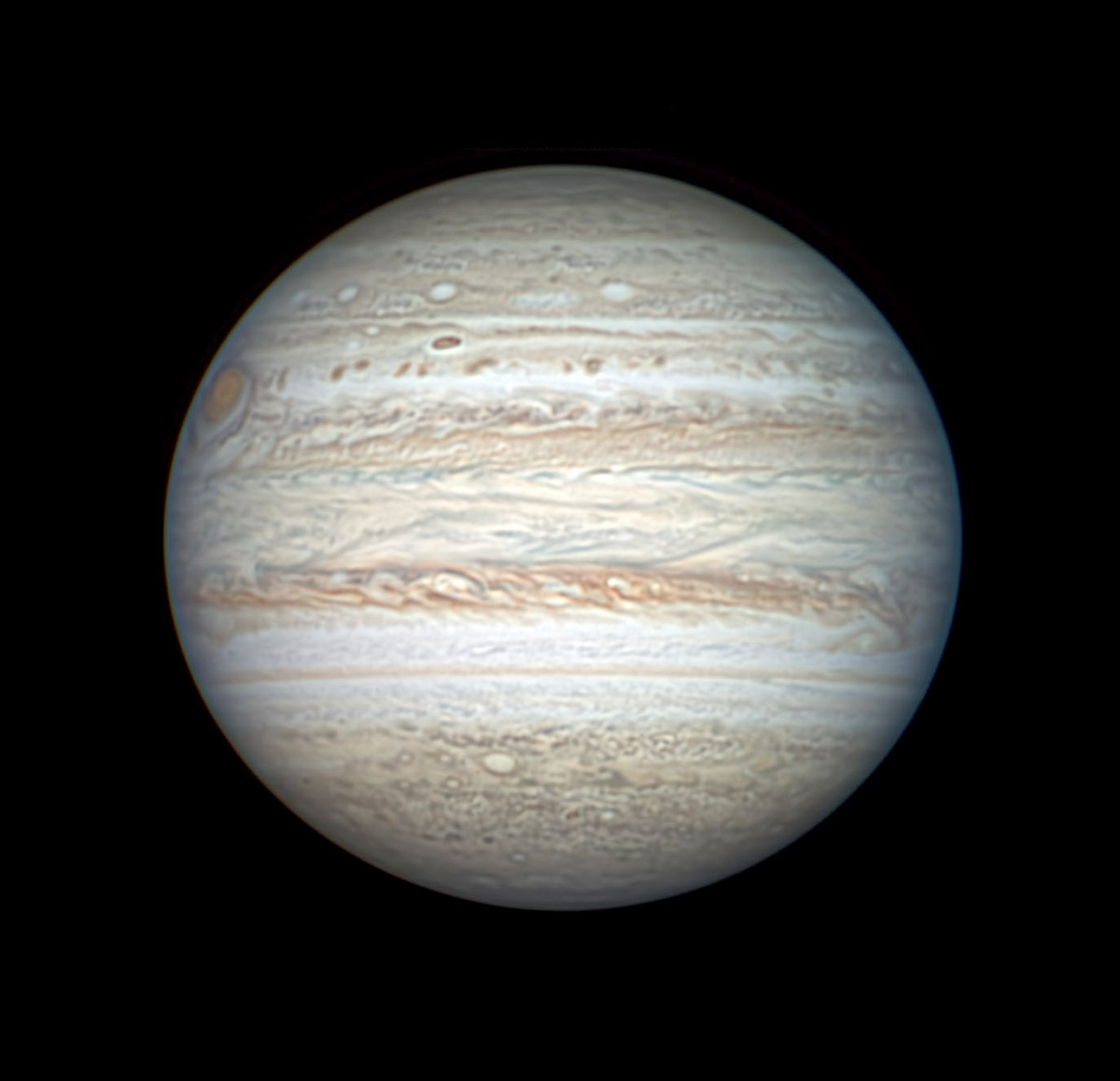
Saturn, magnitude +0.5 in dim Capricornus, crosses the southern sky in the evening. It's about four fists to the right of Jupiter during and after the end of twilight, and lower right of Jupiter as evening grows late. Saturn is highest due south around 9 p.m.
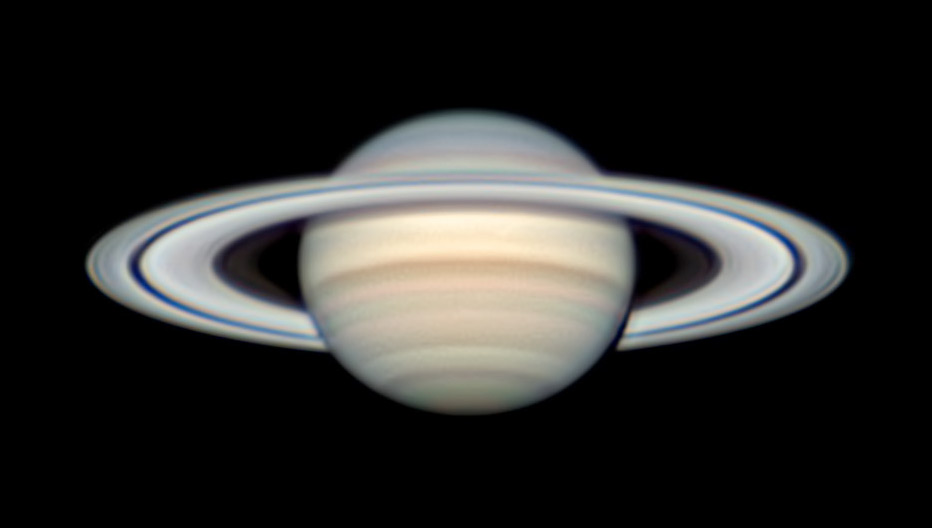
The gray band seen on the globe along the inner edge of the rings is not a belt or a shadow but the semi-transparent C ring.
Uranus, magnitude 5.7 in Aries, is up in the east in good binocular or telescope view by late evening. See the Uranus finder charts in the November Sky & Telescope, page 49.
Neptune, magnitude 7.8 at the Aquarius-Pisces border, is higher in evening about 8° west of Jupiter. See the Neptune finder charts in the September Sky & Telescope, page 49.
All descriptions that relate to your horizon — including the words up, down, right, and left — are written for the world's mid-northern latitudes. Descriptions and graphics that also depend on longitude (mainly Moon positions) are for North America.
Eastern Daylight Time, EDT, is Universal Time minus 4 hours. (Universal Time is also called UT, UTC, GMT or Z time.)
Want to become a better astronomer? Learn your way around the constellations. They're the key to locating everything fainter and deeper to hunt with binoculars or a telescope.
This is an outdoor nature hobby. For an easy-to-use constellation guide covering the whole evening sky, use the big monthly map in the center of each issue of Sky & Telescope, the essential magazine of astronomy.
Once you get a telescope, to put it to good use you'll need a detailed, large-scale sky atlas (set of charts). The basic standard is the Pocket Sky Atlas (in either the original or Jumbo Edition), which shows stars to magnitude 7.6.

Next up is the larger and deeper Sky Atlas 2000.0, plotting stars to magnitude 8.5; nearly three times as many. The next up, once you know your way around, are the even larger Interstellarum atlas (stars to magnitude 9.5) or Uranometria 2000.0 (stars to magnitude 9.75). And be sure to read How to Use a Star Chart with a Telescope. It applies just as much to charts on your phone or tablet as to charts on paper.
You'll also want a good deep-sky guidebook. A beloved old classic is the three-volume Burnham's Celestial Handbook. An impressive more modern one is the big Night Sky Observer's Guide set (2+ volumes) by Kepple and Sanner.
Can a computerized telescope replace charts? Not for beginners, I don't think, and not on mounts and tripods that are less than top-quality mechanically, meaning heavy and expensive. And as Terence Dickinson and Alan Dyer say in their Backyard Astronomer's Guide, "A full appreciation of the universe cannot come without developing the skills to find things in the sky and understanding how the sky works. This knowledge comes only by spending time under the stars with star maps in hand."
![]() Audio sky tour. Out under the evening sky with your
Audio sky tour. Out under the evening sky with your
earbuds in place, listen to Kelly Beatty's monthly
podcast tour of the heavens above. It's free.
"The dangers of not thinking clearly are much greater now than ever before. It's not that there's something new in our way of thinking, it's that credulous and confused thinking can be much more lethal in ways it was never before."
— Carl Sagan, 1996
"Facts are stubborn things."
— John Adams, 1770
 9
9









Comments
Rod
October 7, 2022 at 12:56 pm
Well, skies cleared 🙂 Early this morning near 0530 EDT, I noticed Mars shining brightly above. Mars is calling me now for some telescope time 🙂 Last night, I was able to get out into the fields and enjoy Jupiter, Moon, and Saturn.
Observed 2000-2100 EDT. Full Moon 09-Oct-2022 2055 UT/1655 EDT. I enjoyed some observing of Jupiter, waxing gibbous Moon, and Saturn this evening after a week of clouds and rain. I used the 90-mm refractor telescope with TeleVue 14-mm Delos, Moon filter, and #58 Green filter. Some very interesting views of the Moon using the green filter as well as Moon filter. Crater detail visible along the terminator line. Other craters, Tycho stood out, Copernicus crater, Kepler, Aristarchus, Eratosthenes, Plato, Archimedes, Aristillus, Autolycus. At Jupiter I could see cloud belts and banding along with shading in the north polar region. 4 Galilean moons visible. In the north up, mirror reverse view, Ganymede, Io, and Europa on left side, Callisto on the right side. Saturn was enjoyable with rings, some cloud banding noticeable. Titan visible on right, Rhea visible on left side, mirror reverse view. Sometimes Tethys was visible but Titan and Rhea easier to see. The fields were very wet tonight with dew forming quickly all over so I did not stay out long. Some altocumulus and cirrus bands moved by, temperature 13C, winds calm. At 2030 EDT, Stellarium 1.0 showed Jupiter 25-degrees, 33 arcminute angular separation from the Moon in Aquarius. Saturn 18-degrees, 44 arcminute angular separation from the Moon. Magnification 71x with a bit more than 1-degree true FOV in the eyepiece. Virtual Moon Atlas shows the Moon’s angular size ~ 32.49 arcminutes.
You must be logged in to post a comment.
Rod
October 7, 2022 at 5:13 pm
"Titan visible on right, Rhea visible on left side, mirror reverse view." This was the terrestrial upright view, not mirror reverse view, oops 🙂
You must be logged in to post a comment.
misha17
October 7, 2022 at 9:37 pm
Since October 9th is about six months away from April 8th, the Full Moon will be roughly in the same place in the sky as it will be for the April 8th 2024 solar eclipse.
If no one beats me to it, I will post a reply comment in a bit to see exactly when the moon is at the April 8th Right Ascension, and how much time to offset Oct 9th lunar positions (moonrise, transit/culmination, moonset) so that they are similar to April 8th solar positions.
You must be logged in to post a comment.
misha17
October 7, 2022 at 9:40 pm
1st pragraph should have read,
"Since October 9th is about six months away from April 8th, the Full Moon will be roughly in the same place in the sky as the sun (and New Moon) will be for the April 8th 2024 solar eclipse."
If no one beats me to it, I will post a rep
You must be logged in to post a comment.
misha17
October 8, 2022 at 10:13 pm
On April 8th, 2024, at 3pm EDT the Sun will be at Right Ascension 1hr 11min. Its declination will be +7 1/2 degrees.
On October 9th, 2022, the Moon will be at RA 1hr 11min at about 7pm EDT, just about at Moonrise. However, it's declination will only be +4 degrees
(what a difference 18 months makes in lunar declination changes!)
Still worth a try to use the Hunter's Moon as a proxy for the April 8th Sun,
The Moon's motion durng the night will shift it away from the Sun's April 8th RA, but the 3-degree difference in declination will already make this only a rough simulation
You must be logged in to post a comment.
New Jersey Eclipse Fan
October 9, 2022 at 4:36 pm
It's always great reading everyone's posts. At sundown tonight, Jews will begin our annual celebration of the autumn harvest with the arrival of Sukkot, the Festival of Tabernacles. The most important part of the structure is the flat roof, 100% consisting of former-living material, such as (cut) tree branches and cornstalks; loose bamboo and bamboo mats are the most popular choice. Although the majority of the roof is covered, there has to be enough space in between to be able to view...the stars! And we always have a full moon for natural nighttime illumination, since the holiday falls on the evening following the 14th day of the Jewish lunar month of Tishrei--depending on clear skies, of course! The weather forecast here in Central Jersey is predicted to be quite favorable for the duration of the holiday, which this year ends on the evening of Sunday, October 16th. My family and I are looking forward to being outside in our sweaters beginning this evening!
You must be logged in to post a comment.
Rod
October 9, 2022 at 7:55 pm
New Jersey Eclipse Fan, it is a gorgeous evening tonight. I was out a bit ago and enjoyed looking at the Hunter's Moon rising in Pisces. Jupiter ascending higher in Pisces, and Saturn up in Capricornus. I may get out my 90-mm refractor telescope soon and look at Saturn and Jupiter. Wonderful, early Fall evening in MD.
You must be logged in to post a comment.
Rod
October 9, 2022 at 10:37 pm
Okay, I did use my telescope this evening. Observed 2030-2130 EDT/0030 UT-0130 UT. Full Moon 09-Oct-2022 2055 UT or 1655 EDT. This was a lovely sight, Hunter's Moon tonight. At Jupiter, Io shadow transit underway from 0014 UT to 0228 UT according to the October issue of Sky & Telescope on page 51. This was easily visible using my 90-mm refractor telescope at 129x using #58 Green filter. Above the NEB there was distinct cloud shading visible and some below the SEB and banding. In the direct view, Ganymede was on the left and Europa and Callisto visible on the right side while the shadow of Io moved across the face of Jupiter. Viewing the Hunter’s Moon at 129x using #58 Green filter, I spent some time in the Mare Humboldtianum region and lunar limb. Edymion crater visible as well as Hayn crater area. Tycho crater very prominent in SW quadrant. See Virtual Moon Atlas. Weather clear, temperature 6C, light to calm wind. A great night for camping. Some owls were out hooting and deer barking or calling in the woods. Bucks in the woods are active now.
You must be logged in to post a comment.
Rod
October 12, 2022 at 8:07 am
I enjoyed last night's sky show with the Moon and Uranus 🙂 I was out from 2200-0130 EDT this morning. Some parts of the US last night could see the Moon occult Uranus. The Moon and Uranus about 13 arcminutes apart at 0130 EDT when I came in and closer near 10 arcminutes near 0200 EDT this morning at my site. That was enjoyable. I came in at 0130, the Moon and Uranus separated by 13 arcminutes at the time. Nearest approach for my location about 10 arcminutes near 0200 EDT. At 71x, I kept Tycho crater area and lunar limb in view along with Uranus. Earlier I used different filters but as the Moon's orbit carried it closer and closer to Uranus position, I switched to no filter views. Uranus becoming more difficult to see with different filters used as the Moon got closer to Uranus. The entire waning gibbous Moon in the eyepiece with Uranus looked like a big pizza pie right smack in my eye 🙂 It was amore but very bright 🙂 Mars was up, I looked at Mars too at 71x. Mars 13 arcsecond angular size now so some surface detail noticeable. Higher power will show more. Mars rose above a tree line near 2356 EDT and easy for me to see where I was sitting with the telescope in back section on paved area, not way out in the fields and pastures. I enjoyed following the Moon move closer to Uranus at 25x, 31x, 129x, and 71x views. At 129x, Uranus was a small, circular or disk shape planet, pale blue-green color. When I enjoy looking at Neptune, it is very distinct blue color.
You must be logged in to post a comment.
You must be logged in to post a comment.